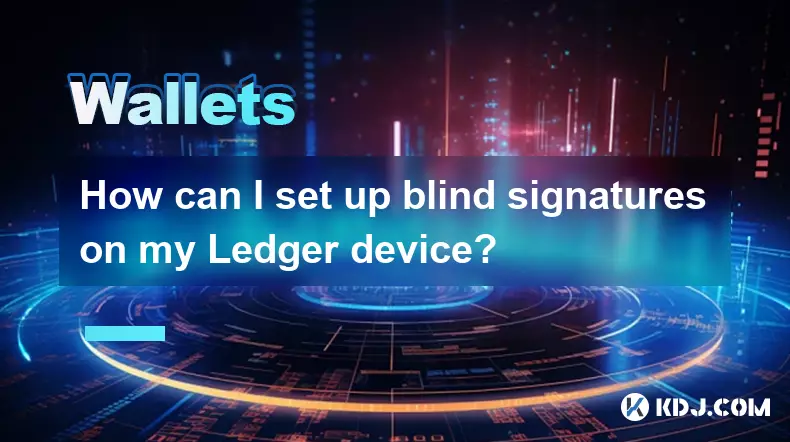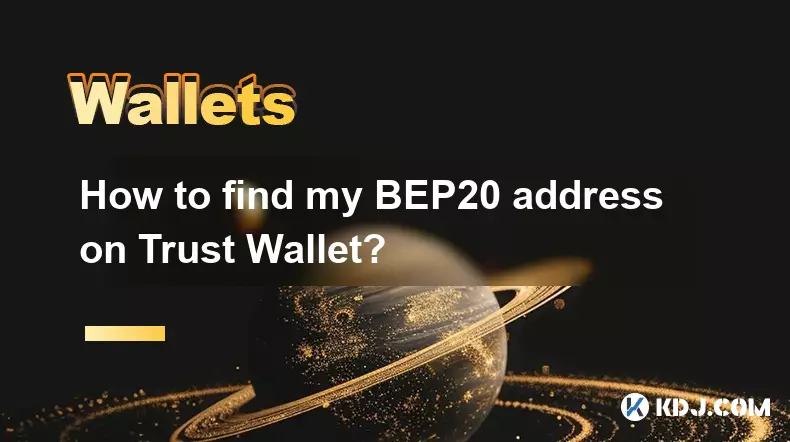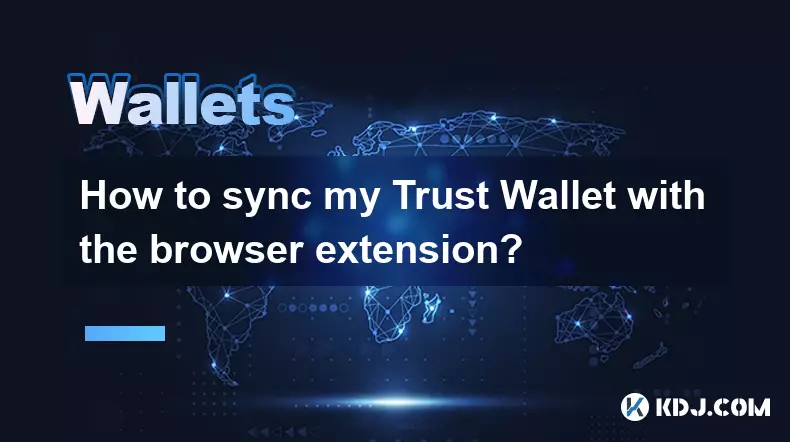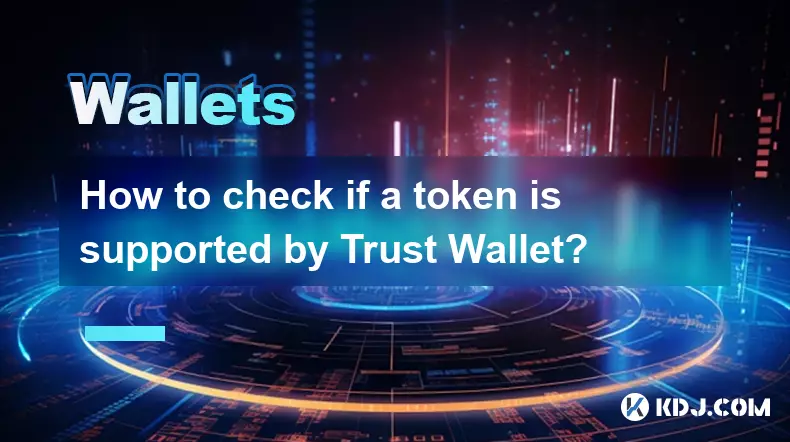-
 bitcoin
bitcoin $122288.232522 USD
0.16% -
 ethereum
ethereum $4480.662914 USD
-0.22% -
 xrp
xrp $2.962747 USD
-2.32% -
 tether
tether $1.000120 USD
-0.05% -
 bnb
bnb $1145.654223 USD
-2.07% -
 solana
solana $227.105217 USD
-1.67% -
 usd-coin
usd-coin $0.999548 USD
-0.02% -
 dogecoin
dogecoin $0.250875 USD
-2.04% -
 tron
tron $0.340654 USD
-0.49% -
 cardano
cardano $0.837968 USD
-2.52% -
 hyperliquid
hyperliquid $48.960449 USD
0.06% -
 chainlink
chainlink $22.049280 USD
-1.33% -
 ethena-usde
ethena-usde $1.000404 USD
0.02% -
 sui
sui $3.586212 USD
0.20% -
 avalanche
avalanche $29.894916 USD
-4.18%
How can I set up blind signatures on my Ledger device?
Blind signatures let messages be signed without revealing content, enhancing privacy in crypto transactions, though Ledger devices don’t natively support them.
Sep 27, 2025 at 08:00 pm

Understanding Blind Signatures in Cryptocurrency
1. Blind signatures are a cryptographic method that allows a message to be signed without revealing its content to the signer. This technique plays a crucial role in privacy-focused blockchain protocols where transaction details must remain confidential during verification processes. In the context of cryptocurrency wallets, particularly hardware devices like Ledger, blind signatures can enhance user privacy by preventing exposure of sensitive data during multisig or threshold signing operations.
2. The core idea behind blind signatures is rooted in RSA cryptography, where a user 'blinds' a message using a random value before sending it to the signer. After the signer applies their private key, the user removes the blinding factor to obtain a valid signature on the original message. While modern blockchains often use ECDSA or Schnorr signatures, adapted forms of blinding techniques have been explored for use in decentralized environments.
3. Not all cryptocurrencies support blind signatures natively. Protocols such as Monero and Zcash emphasize privacy through different mechanisms like ring signatures and zk-SNARKs. However, certain experimental wallet setups and layer-two solutions may integrate blinding techniques to improve anonymity in signing procedures, especially when third-party signers are involved.
Ledger Device Capabilities and Limitations
1. Ledger hardware wallets operate using a secure element chip that isolates private keys from external access. They support a wide range of cryptocurrencies and standards, including ERC-20 tokens and BIP39-based derivation paths. However, Ledger does not currently offer native support for blind signature schemes within its firmware or official applications.
2. The Ledger ecosystem relies on deterministic signing methods where the device verifies transaction details before signing. This design prioritizes security over privacy-preserving features like blinding, as exposing unverified data could introduce vulnerabilities. As a result, any implementation of blind signatures would require modifications outside Ledger’s standard workflow.
3. Developers seeking advanced cryptographic functions must rely on custom apps or external tools that interface with Ledger via APIs such as Ledger Live SDK or WebHID. These approaches allow for extended functionality but come with increased complexity and potential risks if not properly audited.
Alternative Approaches for Privacy-Enhanced Signing
1. Some decentralized protocols implement threshold signatures or multi-party computation (MPC) to achieve similar privacy goals. These methods distribute signing authority across multiple parties, ensuring no single entity sees the full transaction until completion. While not blind signatures per se, they provide comparable benefits in terms of data confidentiality.
2. Projects like FROST (Flexible Round-Optimized Schnorr Threshold) enable efficient threshold signing with minimal communication rounds. When combined with hardware wallets, these protocols can route partial signatures through secure devices while keeping inputs obscured from direct inspection.
3. Third-party software such as Sparrow Wallet or Core Lightning supports experimental integrations with hardware signers under specific configurations. Users may configure these tools to handle blinded data flows indirectly, though this requires deep technical understanding and careful validation of each step.
4. Another path involves using zero-knowledge proof systems to attest to the correctness of a blinded operation without disclosing underlying values. This approach remains largely theoretical for consumer-grade hardware wallets but is actively researched in academic and development circles.
Security Considerations and Best Practices
1. Attempting to implement non-standard cryptographic protocols on production wallets introduces significant risk. Any deviation from certified firmware routines may compromise the integrity of private key protection, which is the primary advantage of using a Ledger device.
2. Firmware updates from Ledger may invalidate custom configurations or third-party app installations. Users should maintain backups and understand recovery procedures before experimenting with advanced features.
3. Open-source communities occasionally publish patches or experimental branches aimed at extending hardware wallet capabilities. Engaging with these resources requires verifying code authenticity and assessing potential attack vectors introduced by additional dependencies.
4. Always test new setups in isolated environments using small amounts of funds. Simulate various failure scenarios to ensure resilience against unexpected behavior during real-world usage.
Frequently Asked Questions
Can I install custom firmware on my Ledger to enable blind signatures?No, installing unofficial firmware voids warranties and exposes the device to severe security risks. Ledger's secure element is designed to prevent unauthorized modifications, making custom firmware impractical and unsafe.
Are there any wallets that natively support blind signatures?As of now, no mainstream consumer wallet offers built-in blind signature functionality. Research projects and niche privacy tools may demonstrate prototypes, but widespread adoption remains limited due to usability and compatibility challenges.
Does using a hardware wallet with MPC count as a form of blind signing?While MPC enhances privacy by distributing trust, it differs fundamentally from blind signatures. In MPC, participants jointly compute a signature without reconstructing the full key, whereas blind signatures involve concealing the message itself from the signer.
Can blind signatures be used for NFT transactions?Blind signatures are generally unsuitable for NFT transfers, where transparency about asset ownership and metadata is essential. Their application lies more in fungible token systems where unlinkability between transactions is desired.
Disclaimer:info@kdj.com
The information provided is not trading advice. kdj.com does not assume any responsibility for any investments made based on the information provided in this article. Cryptocurrencies are highly volatile and it is highly recommended that you invest with caution after thorough research!
If you believe that the content used on this website infringes your copyright, please contact us immediately (info@kdj.com) and we will delete it promptly.
- BlockDAG, DOGE, HYPE Sponsorship: Crypto Trends Shaping 2025
- 2025-10-01 00:25:13
- Deutsche Börse and Circle: A StableCoin Adoption Powerhouse in Europe
- 2025-10-01 00:25:13
- BlockDAG's Presale Buzz: Is It the Crypto to Watch in October 2025?
- 2025-10-01 00:30:13
- Bitcoin, Crypto, and IQ: When Genius Meets Digital Gold?
- 2025-10-01 00:30:13
- Stablecoins, American Innovation, and Wallet Tokens: The Next Frontier
- 2025-10-01 00:35:12
- NBU, Coins, and Crypto in Ukraine: A New Yorker's Take
- 2025-10-01 00:45:14
Related knowledge

How to find my BEP20 address on Trust Wallet?
Oct 04,2025 at 06:19pm
Understanding BEP20 and Trust Wallet Compatibility1. Trust Wallet is a widely used cryptocurrency wallet that supports multiple blockchain networks, i...

How to sync my Trust Wallet with the browser extension?
Oct 03,2025 at 06:19pm
Understanding Trust Wallet and Browser Extension IntegrationTrust Wallet is a popular non-custodial cryptocurrency wallet that supports a wide range o...

How to check if a token is supported by Trust Wallet?
Oct 04,2025 at 05:18am
Understanding Token Compatibility with Trust Wallet1. Trust Wallet supports a wide range of blockchain networks, including Ethereum, Binance Smart Cha...

How to get the Trust Wallet browser extension?
Oct 01,2025 at 12:37am
How to Access the Trust Wallet Browser Extension1. Visit the official Trust Wallet website through a secure internet connection. Navigate to the downl...

How to interact with a DApp using Trust Wallet?
Oct 02,2025 at 10:00pm
Connecting Trust Wallet to a DApp1. Open the Trust Wallet app on your mobile device and ensure your wallet is unlocked with access to your assets. Nav...

How to scan a QR code with Trust Wallet?
Oct 02,2025 at 03:37pm
Understanding QR Codes in Trust Wallet1. QR codes are widely used in cryptocurrency applications to simplify transaction processes. Trust Wallet lever...

How to find my BEP20 address on Trust Wallet?
Oct 04,2025 at 06:19pm
Understanding BEP20 and Trust Wallet Compatibility1. Trust Wallet is a widely used cryptocurrency wallet that supports multiple blockchain networks, i...

How to sync my Trust Wallet with the browser extension?
Oct 03,2025 at 06:19pm
Understanding Trust Wallet and Browser Extension IntegrationTrust Wallet is a popular non-custodial cryptocurrency wallet that supports a wide range o...

How to check if a token is supported by Trust Wallet?
Oct 04,2025 at 05:18am
Understanding Token Compatibility with Trust Wallet1. Trust Wallet supports a wide range of blockchain networks, including Ethereum, Binance Smart Cha...

How to get the Trust Wallet browser extension?
Oct 01,2025 at 12:37am
How to Access the Trust Wallet Browser Extension1. Visit the official Trust Wallet website through a secure internet connection. Navigate to the downl...

How to interact with a DApp using Trust Wallet?
Oct 02,2025 at 10:00pm
Connecting Trust Wallet to a DApp1. Open the Trust Wallet app on your mobile device and ensure your wallet is unlocked with access to your assets. Nav...

How to scan a QR code with Trust Wallet?
Oct 02,2025 at 03:37pm
Understanding QR Codes in Trust Wallet1. QR codes are widely used in cryptocurrency applications to simplify transaction processes. Trust Wallet lever...
See all articles










































































